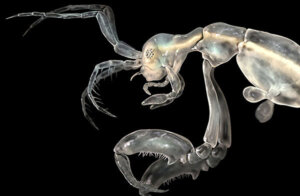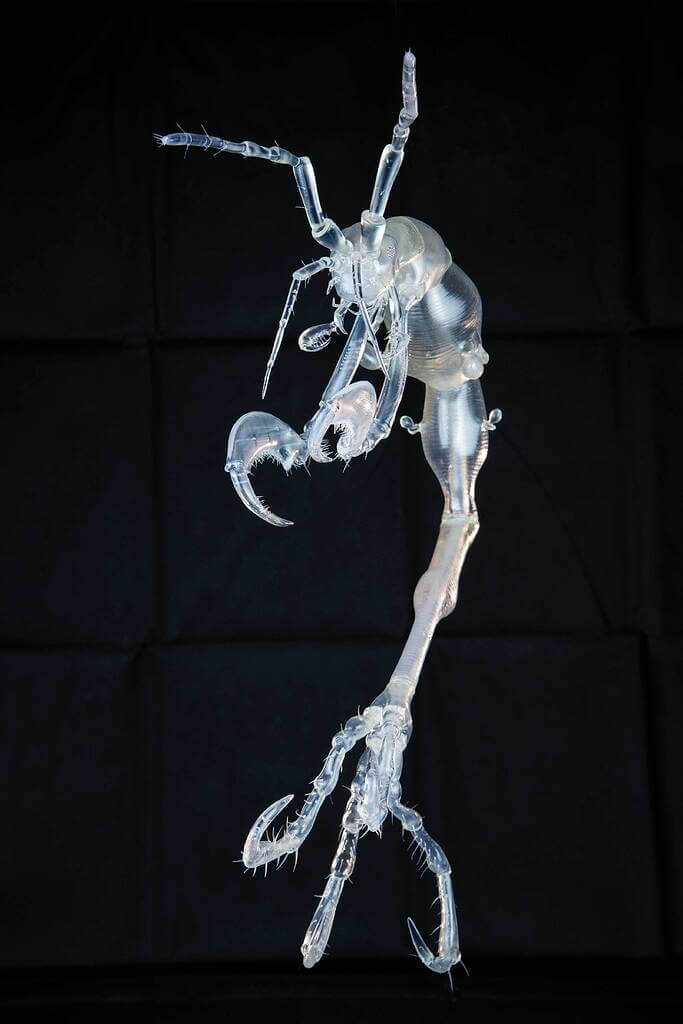All About the Skeleton Shrimp


Written and verified by the biologist Cesar Paul Gonzalez Gonzalez
The skeleton shrimp is a peculiar invertebrate that has a transparent “skin”, which allows its “skeleton” to be seen. Thanks to this characteristic, specimens can blend into their environment and go unnoticed by predators.
The term “skeleton shrimp” doesn’t refer to a single species, but rather to the entire Caprellidae family. However, there’s a new member of this group whose scientific name is Liropus minusculus, and so the following article will deal with this specimen in depth. Keep reading and learn more about the curious skeleton shrimp!
Habitat and distribution
The first known specimen of this species was found at a depth of 30 meters (nearly 100 feet) in a cavern off the coast of Catalina Island, California. However, it’s believed to be distributed throughout the northeastern Pacific Ocean. This is in stark contrast to the rest of the Caprellidae family, as most of its relatives live in the Atlantic or Mediterranean Sea.
Because of its appearance, the skeleton shrimp goes largely unnoticed by predators, so it tends to remain exposed on rocks and plants. In addition, it shares its habitat with several marine invertebrate animals such as hydrozoans and bryozoans, with which it mimics to give the impression of another filament of its body.
Physical characteristics of the skeleton shrimp
As mentioned, the main characteristic of this peculiar shrimp is that it has a translucent body that reveals a type of filament similar to a “skeleton”. It should be noted that this structure doesn’t represent its bones, since arthropods lack bone structure and present exoskeletons. Therefore, the “skeleton” observed is actually a visual trick to mimic the environment.
The skeleton shrimp is extremely small, measuring only between 2.1 and 3.3 millimeters (0.08 to 0.12 inches) in length. This means that it’s almost invisible to the human eye. However, its body maintains the typical “C” shape seen in commonly consumed shrimp. In fact, due to their translucent appearance, they’re also known as ghost shrimp.
The body of the skeleton shrimp maintains the same structure as other amphipods, which consists of 13 divisions or blocks called metameres. Each of these sections contains two pairs of legs used for swimming, but the first two are modified into claws for catching and hunting, while its last pairs of legs are designed to attach to the substrate.
Behavior
Contrary to what one might think, the skeleton shrimp is a natural predator that keeps its eyes open to catch its prey. Because its body goes unnoticed in the environment, all it has to do is wait patiently for its victims to approach, almost like a mantis. Because of this, they spend a lot of time motionless on rocks or marine vegetation.
Skeleton shrimp diet
In general, skeleton shrimp are noted for their omnivorous diet, which consists of a wide variety of microorganisms smaller than themselves. Among the most popular are diatoms, detritus, some worms, various types of protozoa, and even some crustacean larvae.

Reproduction
Unfortunately, because the skeleton shrimp was first discovered in 2013, there isn’t much information about its reproduction. Despite this, it’s believed that it may follow the same mating pattern as its closest relatives. This means that its reproductive cycle takes place just after ecdysis (molting), since only at this time is it possible for the male to fertilize the female.
These organisms fertilize their eggs externally. However, the female captures the eggs and keeps them in a small “pouch” in her belly. As soon as they hatch, the young have the appearance of an adult, but much smaller.
Although it’s true that much information is still unknown about the skeleton shrimp, it’s fascinating to observe how it has adapted to its environment. Its characteristics have allowed it to become a fierce predator despite its size, which is an advantage in the ocean. This is a perfect example of how wonderful nature is and its ability to create such incredible species.
The skeleton shrimp is a peculiar invertebrate that has a transparent “skin”, which allows its “skeleton” to be seen. Thanks to this characteristic, specimens can blend into their environment and go unnoticed by predators.
The term “skeleton shrimp” doesn’t refer to a single species, but rather to the entire Caprellidae family. However, there’s a new member of this group whose scientific name is Liropus minusculus, and so the following article will deal with this specimen in depth. Keep reading and learn more about the curious skeleton shrimp!
Habitat and distribution
The first known specimen of this species was found at a depth of 30 meters (nearly 100 feet) in a cavern off the coast of Catalina Island, California. However, it’s believed to be distributed throughout the northeastern Pacific Ocean. This is in stark contrast to the rest of the Caprellidae family, as most of its relatives live in the Atlantic or Mediterranean Sea.
Because of its appearance, the skeleton shrimp goes largely unnoticed by predators, so it tends to remain exposed on rocks and plants. In addition, it shares its habitat with several marine invertebrate animals such as hydrozoans and bryozoans, with which it mimics to give the impression of another filament of its body.
Physical characteristics of the skeleton shrimp
As mentioned, the main characteristic of this peculiar shrimp is that it has a translucent body that reveals a type of filament similar to a “skeleton”. It should be noted that this structure doesn’t represent its bones, since arthropods lack bone structure and present exoskeletons. Therefore, the “skeleton” observed is actually a visual trick to mimic the environment.
The skeleton shrimp is extremely small, measuring only between 2.1 and 3.3 millimeters (0.08 to 0.12 inches) in length. This means that it’s almost invisible to the human eye. However, its body maintains the typical “C” shape seen in commonly consumed shrimp. In fact, due to their translucent appearance, they’re also known as ghost shrimp.
The body of the skeleton shrimp maintains the same structure as other amphipods, which consists of 13 divisions or blocks called metameres. Each of these sections contains two pairs of legs used for swimming, but the first two are modified into claws for catching and hunting, while its last pairs of legs are designed to attach to the substrate.
Behavior
Contrary to what one might think, the skeleton shrimp is a natural predator that keeps its eyes open to catch its prey. Because its body goes unnoticed in the environment, all it has to do is wait patiently for its victims to approach, almost like a mantis. Because of this, they spend a lot of time motionless on rocks or marine vegetation.
Skeleton shrimp diet
In general, skeleton shrimp are noted for their omnivorous diet, which consists of a wide variety of microorganisms smaller than themselves. Among the most popular are diatoms, detritus, some worms, various types of protozoa, and even some crustacean larvae.

Reproduction
Unfortunately, because the skeleton shrimp was first discovered in 2013, there isn’t much information about its reproduction. Despite this, it’s believed that it may follow the same mating pattern as its closest relatives. This means that its reproductive cycle takes place just after ecdysis (molting), since only at this time is it possible for the male to fertilize the female.
These organisms fertilize their eggs externally. However, the female captures the eggs and keeps them in a small “pouch” in her belly. As soon as they hatch, the young have the appearance of an adult, but much smaller.
Although it’s true that much information is still unknown about the skeleton shrimp, it’s fascinating to observe how it has adapted to its environment. Its characteristics have allowed it to become a fierce predator despite its size, which is an advantage in the ocean. This is a perfect example of how wonderful nature is and its ability to create such incredible species.
All cited sources were thoroughly reviewed by our team to ensure their quality, reliability, currency, and validity. The bibliography of this article was considered reliable and of academic or scientific accuracy.
- Sánchez-Moyano, J. E., García-Asencio, I., & Guerra-García, J. M. (2015). Littoral caprellids (Crustacea: Amphipoda) from the Mexican Central Pacific coast, with the description of four new species. Journal of Natural History, 49(1-2), 77-127.
- Guerra-Garcia, J. M., & Hendrycks, E. A. (2013). A new species of Liropus (Crustacea, Amphipoda, Caprellidae) from California, USA, with an illustrated key of the genus. Zootaxa, 3718(5), 467-476.
- Mauro, F. D. M., & Serejo, C. S. (2015). The family Caprellidae (Amphipoda: Caprelloidea: Caprellidae) from Campos Basin, Southwestern Atlantic, with a key of species occurring in Brazil. Zootaxa, 4006(1), 103-127.
- Guerra-Garcia, J. M., Chatterjee, T., & Schizas, N. V. (2015). New genus and new species of Caprellidae (Crustacea: Peracarida: Amphipoda) from the mesophotic coral ecosystems of Puerto Rico and St. Croix, Caribbean Sea. Zootaxa, 4018(1), 80-96.
This text is provided for informational purposes only and does not replace consultation with a professional. If in doubt, consult your specialist.








